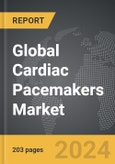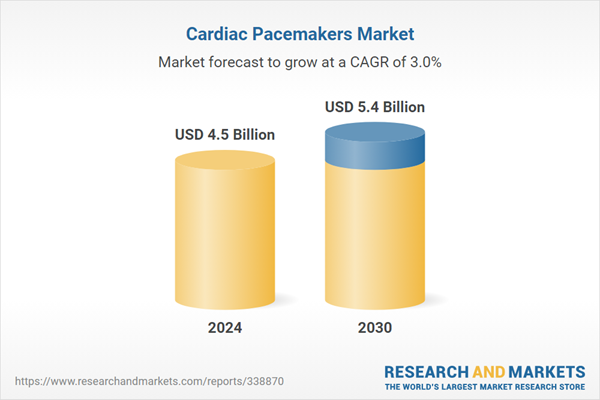The global market for Cardiac Pacemakers was valued at US$4.5 Billion in 2024 and is projected to reach US$5.4 Billion by 2030, growing at a CAGR of 3.0% from 2024 to 2030. This comprehensive report provides an in-depth analysis of market trends, drivers, and forecasts, helping you make informed business decisions. The report includes the most recent global tariff developments and how they impact the Cardiac Pacemakers market.
In recent years, cardiac pacemakers have evolved significantly in terms of technology and design. Modern pacemakers are equipped with advanced features such as rate-responsive pacing, which adjusts the heart rate according to the patient's physical activity, wireless telemetry for remote monitoring, and algorithms that can adapt pacing therapies based on real-time cardiac data. These innovations not only enhance the device's effectiveness in managing various types of arrhythmias but also improve patient outcomes by providing more personalized and responsive care. The market for cardiac pacemakers is expanding globally due to several key factors. Technological advancements continue to drive market growth, with ongoing research leading to more sophisticated and reliable devices. Increasing prevalence of cardiovascular diseases, particularly among the aging population, is also a significant factor contributing to the rising demand for pacemakers. Moreover, improvements in healthcare infrastructure and growing awareness about cardiac health are encouraging more individuals to seek timely diagnosis and treatment, further boosting market growth. Additionally, regulatory initiatives aimed at ensuring the safety and efficacy of medical devices are fostering a conducive environment for market expansion. As a result, the cardiac pacemaker market is poised for continued growth, with innovations and demographic trends shaping its trajectory in the coming years.
Advancements in battery technology and materials science are enabling the development of smaller and more durable pacemakers, reducing the need for frequent replacements and improving patient comfort. Expanding applications beyond traditional indications, such as pacing therapies for heart failure and atrial fibrillation, are broadening the market's scope and addressing unmet medical needs. Thirdly, the integration of artificial intelligence and machine learning algorithms into pacemaker systems is enhancing diagnostic capabilities and optimizing treatment strategies. Moreover, increasing adoption of telemedicine and remote monitoring solutions is facilitating better patient management and reducing healthcare costs associated with in-person consultations. Lastly, partnerships between medical device manufacturers and healthcare providers are promoting collaborative research efforts and accelerating the pace of innovation in cardiac rhythm management. These factors collectively underscore a promising future for the cardiac pacemaker market, characterized by technological innovation, expanded therapeutic applications, and improved patient outcomes.
Segments: Product (Implantable Pacemaker Devices, External Pacemaker Devices); Technology (Single Chamber, Dual Chamber, Biventricular); End-Use (Hospitals & Cardiac Centers, Ambulatory Surgery Centers).
Geographic Regions/Countries: World; United States; Canada; Japan; China; Europe (France; Germany; Italy; United Kingdom; Spain; Russia; and Rest of Europe); Asia-Pacific (Australia; India; South Korea; and Rest of Asia-Pacific); Latin America (Argentina; Brazil; Mexico; and Rest of Latin America); Middle East (Iran; Israel; Saudi Arabia; United Arab Emirates; and Rest of Middle East); and Africa.
The analysts continuously track trade developments worldwide, drawing insights from leading global economists and over 200 industry and policy institutions, including think tanks, trade organizations, and national economic advisory bodies. This intelligence is integrated into forecasting models to provide timely, data-driven analysis of emerging risks and opportunities.
Cardiac Pacemakers
- Key Trends and Drivers
Cardiac pacemakers are sophisticated medical devices designed to manage irregular heartbeats, medically known as arrhythmias. These devices consist of a small, battery-operated generator and leads (wires) that deliver electrical impulses to the heart muscle to regulate its rhythm. Implantable pacemakers are typically placed under the skin in the chest area, with the leads threaded through veins into the heart. The pacemaker monitors the heart's electrical activity and delivers electrical pulses when necessary to ensure the heart beats at a proper rate.In recent years, cardiac pacemakers have evolved significantly in terms of technology and design. Modern pacemakers are equipped with advanced features such as rate-responsive pacing, which adjusts the heart rate according to the patient's physical activity, wireless telemetry for remote monitoring, and algorithms that can adapt pacing therapies based on real-time cardiac data. These innovations not only enhance the device's effectiveness in managing various types of arrhythmias but also improve patient outcomes by providing more personalized and responsive care. The market for cardiac pacemakers is expanding globally due to several key factors. Technological advancements continue to drive market growth, with ongoing research leading to more sophisticated and reliable devices. Increasing prevalence of cardiovascular diseases, particularly among the aging population, is also a significant factor contributing to the rising demand for pacemakers. Moreover, improvements in healthcare infrastructure and growing awareness about cardiac health are encouraging more individuals to seek timely diagnosis and treatment, further boosting market growth. Additionally, regulatory initiatives aimed at ensuring the safety and efficacy of medical devices are fostering a conducive environment for market expansion. As a result, the cardiac pacemaker market is poised for continued growth, with innovations and demographic trends shaping its trajectory in the coming years.
Advancements in battery technology and materials science are enabling the development of smaller and more durable pacemakers, reducing the need for frequent replacements and improving patient comfort. Expanding applications beyond traditional indications, such as pacing therapies for heart failure and atrial fibrillation, are broadening the market's scope and addressing unmet medical needs. Thirdly, the integration of artificial intelligence and machine learning algorithms into pacemaker systems is enhancing diagnostic capabilities and optimizing treatment strategies. Moreover, increasing adoption of telemedicine and remote monitoring solutions is facilitating better patient management and reducing healthcare costs associated with in-person consultations. Lastly, partnerships between medical device manufacturers and healthcare providers are promoting collaborative research efforts and accelerating the pace of innovation in cardiac rhythm management. These factors collectively underscore a promising future for the cardiac pacemaker market, characterized by technological innovation, expanded therapeutic applications, and improved patient outcomes.
Report Scope
The report analyzes the Cardiac Pacemakers market, presented in terms of units. The analysis covers the key segments and geographic regions outlined below.Segments: Product (Implantable Pacemaker Devices, External Pacemaker Devices); Technology (Single Chamber, Dual Chamber, Biventricular); End-Use (Hospitals & Cardiac Centers, Ambulatory Surgery Centers).
Geographic Regions/Countries: World; United States; Canada; Japan; China; Europe (France; Germany; Italy; United Kingdom; Spain; Russia; and Rest of Europe); Asia-Pacific (Australia; India; South Korea; and Rest of Asia-Pacific); Latin America (Argentina; Brazil; Mexico; and Rest of Latin America); Middle East (Iran; Israel; Saudi Arabia; United Arab Emirates; and Rest of Middle East); and Africa.
Key Insights:
- Market Growth: Understand the significant growth trajectory of the Implantable Pacemaker Devices segment, which is expected to reach US$3.3 Billion by 2030 with a CAGR of a 2.6%. The External Pacemaker Devices segment is also set to grow at 3.7% CAGR over the analysis period.
- Regional Analysis: Gain insights into the U.S. market, valued at $1.2 Billion in 2024, and China, forecasted to grow at an impressive 5.0% CAGR to reach $1.1 Billion by 2030. Discover growth trends in other key regions, including Japan, Canada, Germany, and the Asia-Pacific.
Why You Should Buy This Report:
- Detailed Market Analysis: Access a thorough analysis of the Global Cardiac Pacemakers Market, covering all major geographic regions and market segments.
- Competitive Insights: Get an overview of the competitive landscape, including the market presence of major players across different geographies.
- Future Trends and Drivers: Understand the key trends and drivers shaping the future of the Global Cardiac Pacemakers Market.
- Actionable Insights: Benefit from actionable insights that can help you identify new revenue opportunities and make strategic business decisions.
Key Questions Answered:
- How is the Global Cardiac Pacemakers Market expected to evolve by 2030?
- What are the main drivers and restraints affecting the market?
- Which market segments will grow the most over the forecast period?
- How will market shares for different regions and segments change by 2030?
- Who are the leading players in the market, and what are their prospects?
Report Features:
- Comprehensive Market Data: Independent analysis of annual sales and market forecasts in US$ Million from 2024 to 2030.
- In-Depth Regional Analysis: Detailed insights into key markets, including the U.S., China, Japan, Canada, Europe, Asia-Pacific, Latin America, Middle East, and Africa.
- Company Profiles: Coverage of players such as Abbott Laboratories, Inc., Boston Scientific Corporation, Cordis, a Cardinal Health company, Medico SpA, Medtronic PLC and more.
- Complimentary Updates: Receive free report updates for one year to keep you informed of the latest market developments.
Some of the 24 companies featured in this Cardiac Pacemakers market report include:
- Abbott Laboratories, Inc.
- Boston Scientific Corporation
- Cordis, a Cardinal Health company
- Medico SpA
- Medtronic PLC
- Shree Pacetronix Ltd.
- Vitatron Holding BV
- ZOLL Medical Corporation
Tariff Impact Analysis: Key Insights for 2025
Global tariff negotiations across 180+ countries are reshaping supply chains, costs, and competitiveness. This report reflects the latest developments as of April 2025 and incorporates forward-looking insights into the market outlook.The analysts continuously track trade developments worldwide, drawing insights from leading global economists and over 200 industry and policy institutions, including think tanks, trade organizations, and national economic advisory bodies. This intelligence is integrated into forecasting models to provide timely, data-driven analysis of emerging risks and opportunities.
What’s Included in This Edition:
- Tariff-adjusted market forecasts by region and segment
- Analysis of cost and supply chain implications by sourcing and trade exposure
- Strategic insights into geographic shifts
Buyers receive a free July 2025 update with:
- Finalized tariff impacts and new trade agreement effects
- Updated projections reflecting global sourcing and cost shifts
- Expanded country-specific coverage across the industry
Table of Contents
I. METHODOLOGYII. EXECUTIVE SUMMARY2. FOCUS ON SELECT PLAYERSIII. MARKET ANALYSISCANADAITALYSPAINRUSSIAREST OF EUROPESOUTH KOREAREST OF ASIA-PACIFICARGENTINABRAZILMEXICOREST OF LATIN AMERICAIRANISRAELSAUDI ARABIAUNITED ARAB EMIRATESREST OF MIDDLE EASTIV. COMPETITION
1. MARKET OVERVIEW
3. MARKET TRENDS & DRIVERS
4. GLOBAL MARKET PERSPECTIVE
UNITED STATES
JAPAN
CHINA
EUROPE
FRANCE
GERMANY
UNITED KINGDOM
ASIA-PACIFIC
AUSTRALIA
INDIA
LATIN AMERICA
MIDDLE EAST
AFRICA
Companies Mentioned (Partial List)
A selection of companies mentioned in this report includes, but is not limited to:
- Abbott Laboratories, Inc.
- Boston Scientific Corporation
- Cordis, a Cardinal Health company
- Medico SpA
- Medtronic PLC
- Shree Pacetronix Ltd.
- Vitatron Holding BV
- ZOLL Medical Corporation
Table Information
| Report Attribute | Details |
|---|---|
| No. of Pages | 203 |
| Published | April 2025 |
| Forecast Period | 2024 - 2030 |
| Estimated Market Value ( USD | $ 4.5 Billion |
| Forecasted Market Value ( USD | $ 5.4 Billion |
| Compound Annual Growth Rate | 3.0% |
| Regions Covered | Global |









